This is from a presentation I gave to the US Military Historian’s annual meeting 8/6/2006 while serving as the 12th command Sergeant Major of the U.S. Army Materiel Command.
The Changing Role of the Command Sergeant Major
Command Sergeant Major Daniel K. Elder
Frederick von Steuben, author of the first drill manual for George Washington’s Army, wrote in 1774 that the Sergeant Major was at the head of the noncommissioned officers for his Regiment. Von Steuben noted that he should be well acquainted with the disciple of the regiment, keeping rosters, forming details and every other business of the adjutant. Though many duties that we associate with sergeant major are still performed to this day, the most senior NCOs of that era were not advisors to their commander, the Sergeant Major in the Continental Army was an assistant to the Adjutant.
In his 1814 Handbook for Infantry, William Duane stated that the sergeant major was, “to the sergeants and corporals, what the major is to the platoon officers.” In the 1820’s, the sergeant major was directed to conduct both practical and theoretical instruction for sergeants and corporals. In 1909, Captain James A. Moss of the 24th U.S. Infantry produced one of the first guides specifically for the noncommissioned officer, the Noncommissioned Officers’ Manual. In his description of the sergeant major’s duties, he recognized that the sergeant major was responsible for transmitting orders, through the first sergeants, and they would be obeyed just as if they came from the Adjutant.
Moss stated that the sergeant major’s, “neatness and correctness of dress and in soldierly bearing, he should be faultless, setting an example to the rest of the enlisted men of the command.” He also defined the depth of knowledge required by the sergeant major, stating that he must know, “Army Regulations, the Drill Regulations, the Manual of Guard Duty and so much of the Courts-Martial Manual and the other manuals that pertain to his duties.”
In an attempt to reduce costs in June 1920, Congress eliminated the position of sergeant major and grouped enlisted members into seven pay grades (E-1 through E7). The senior noncommissioned officer in an organization for the next thirty-eight years was the senior master sergeant. But it took the Military Pay Bill of 1958 which recommended establishing two new enlisted pay grades E-8 and E-9, the “super grades for the title of Sergeant Major to return. Promotions were first made to E-8, then later on to E-9, the honor of being the first E-9 went to Theodore L. Dobol on April 1, 1959 while at Baumholder, GE. It was not until 1962 that Army Chief of Staff General George Decker decided all personnel holding the grade of E-9 would be called Sergeant Major. A question that would often be asked and go unanswered was “what were the specified duties of the Sergeant Major?”
Two important events happened in the mid-1960 that affected the role of the sergeant major, the first was the establishment of the position of Sergeant Major of the Army. It was initially conceived as an “ombudsman” for enlisted personnel, but its role eventually expanded beyond that. In the 1967 edition of Army Regulation 600-20, Army Command Policy and Procedure, it stated that the position of the Sergeant Major of the Army “serves as the senior enlisted advisor and consultant to the Chief of Staff of the Army on problems affecting enlisted personnel and their solutions. Since then the duties and responsibilities of the person holding that office have continued to mature.
Under the direction of the Army Chief of Staff, General Harold K. Johnson, the Command Sergeants Major (CSM) Program was established in July 1967. The program would, “create a small body of selected sergeants major for ready assignment to all major commands of the Army.” The Chief of Staff also directed that the insignia of the command sergeant major be changed to make them identifiable. With Johnson recommending that a simple change, such as “…adding a wreath around the star might suffice….” Of the first 192 selectees in December 1967, five of them would ultimately serve as Sergeant Major of the Army.
Once implemented, the role of the command sergeant major was controversial. Some disgruntled commentators complained that CSMs were not commanders and would usurp the lines of authority in the chain of command. Commanders were thought to be under utilizing their CSMs. In his address to senior sergeants during a 1966 Sergeants Major conference, Gen. Johnson warned, “you have to be careful now that in this sergeants major chain you are not establishing some kind of end run position, because this, if it ever developed, and if it were then ever identified, would be the very quickest way to torpedo the whole program. “
After that meeting senior Army commanders gathered for a conference at General William DePuy’s Training and Doctrine Command (TRADOC) headquarters to discuss the role of the CSM. DePuy noted that, “The sergeant major sort of floats around out there and observes what’s going on with soldiers and tells the old man about that. Fine, I think he can do that, but that’s a very limited view of what a sergeant major is supposed to do.” DePuy pointed out that, “The overwhelming number of captains commanding companies…in the Army rejected the claim of the sergeant major to any authority at all over unit noncommissioned officers.”
DePuy then went on to lay the foundation for what is now known as the noncommissioned officer support channel. He wrote that the noncommissioned officer has two responsibilities, “to accomplish an assigned group of collective missions…” and, “to supervise the training of the individual soldiers in that squad, section or crew.” He concluded by stating that it, “should be almost an exclusive responsibility of the first-line supervisors under the direction of and with the support of platoon sergeants, first sergeants, and command sergeants major. But this did not change perception both in and out of the ranks.
Many major commands attempted to define the duties of the command sergeant major, but it took until April 1978 for it to materialize with the publication of C8, Army Regulation 600-20, Army Command Policy. It was there that the noncommissioned officer communication channel was first described, as well as the essential functions of the command sergeant major.
In a May 1986 interview in Army magazine, Korea and Vietnam veteran LTG Robert L. Wetzel summed up how he utilized his sergeant major in combat, “The same way I use him in peacetime–to show the way. I expect the sergeant major to be at or near the point of decision at critical times and provide me, as the commander, with an unbiased assessment.”
In June 1988 BG (Ret.) John C. Banshin and COL (Ret.) James W. Bradin wrote a scathing personal account in the Army publication Parameters describing “The Army’s Command Sergeant Major Problem.” The article went on to report that the CSM had become “the greatest training distracter in the command.” They intoned that there was no need for a senior noncommissioned officer above the First Sergeant and the CSM at division and corps level has “become more ornamental and ceremonial than functional.“ Though panned in many circles, there continued to be an underlying skepticism of the Army’s command sergeant major program, and of some of the men and women who served in those positions.
Partly in response to to the continued misunderstanding of the authorities and responsibilities of NCOs, especially senior NCOs, a Leader Development Task Force was formed in 1989. Drawing heavily from the Professional Army Ethic, the NCO Creed, and the Oath of Enlistment, they codified leadership competencies and the skills, knowledge and attitudes that NCOs, including the command sergeant major and sergeant major, should Be, Know and Do. By formalizing those competencies in Training Circular 22-6, The Army Noncommissioned Officer Guide in November 1990, the roles of the sergeant major (and others) were more clearly defined for all to understand.
So what does the Command Sergeant Major actually do? I myself couldn’t wait to go to the Sergeants Major Academy just so I could find out that answer!! I say that in jest, but it wasn’t far from the truth. According to Army Command Policy, the title Command Sergeant Major designates the senior NCO of the command at battalion or higher levels. They carry out policies and standards, and advise the commander on the performance, training, appearance, and conduct of enlisted Soldiers.
The command sergeant major also administers the unit Noncommissioned Officer’s Development Program (NCODP). Though that is pretty cut and dry, I still reflect back to General DePuy’s comments made more than 30 years ago. Some of these responsibilities translate well in a combat role, but there is little in the way of specified duties on the battlefield.
At the conclusion of Desert Storm, TRADOC Commander Fredrick Franks set out to capture techniques of battlefield commanders and their command sergeants major. Commanders recognized the importance of the role of the sergeant major, and TRADOC collected vignettes and experiences in TRADOC Pamphlet 525-100-2, Leadership and Command on the Battlefield to describe techniques employed during those operations.
General Franks himself noted: “Almost every soldier told me two important things. They all stated that their training was critical in preparing them for the unknowns of combat, and they praised the sergeants who had ensured they were ready for battle.
The Commander of the 1st Brigade, 1st Cavalry Division stated “I didn’t tell my Command Sergeant Major to change anything. We had just come from the National Training Center. We had trained at Home station, we talked everyday about what we needed to do for the brigade. His role was individual training and taking care of soldiers.”
“[During Operation Desert Storm] many battalion commanders commented that their command sergeants major seemed to be everywhere, talking with soldiers, smoothing problems in the logistics and maintenance efforts, and assisting the commander with control of the unit.“
This study concluded with one of the trends that the NCOs were distinguished by their attitude, mission dedication and desire to win in combat.
As we begin our sixth year of the Global War on Terrorism, we recognize that our Army has been engaged in sustained combat, the likes of which haven’t been seen since Vietnam. Though born from Vietnam, the rank of Command Sergeant and the roles of the senior NCO have rightly matured and this latest conflict allows us to evaluate the missions, roles and functions of the Command Sergeant Major in war.
By reviewing the historical leadership perspectives of Senior Enlisted leaders I have listed some trends of how commanders continue to use their senior NCOs.
One trend observed is CSMs ensure that the commander’s intent reaches soldiers at the most basic level, in the company, battery’s and troops of a given unit. CSM Jeff Mellinger, the former CSM to General Casey, then the Multi National Force-Iraq Commander summed it up that “commanders routinely make observations and give directions and tasks during meetings. Sometimes those directions get filtered down to the lowest echelons and the message has changed.” He saw as his role to listen to and understand those words and as he traveled through the Area of Operation to ensure the commander’s words were properly delivered. He also noted that he could also pass issues and concerns back up the other direction. That is the second bullet, providing feedback.
Another prevalent theme that suits the role of the CSM is battlefield circulation…or better known as showing the flag and going out and walking, talking and generally just being with soldiers. Third Army Sergeant Major Frank Ashe noted the CSM is an extension of the commander and can serve as an extra set of eyes and ears. The CSM carries the commander’s message to the troops, in support of the commander.
CSM William Gainey, Former III Corps Sergeant Major and now Senior Enlisted Advisor to the Chairman of the Joint Chiefs of Staff, noted his commander LTG Thomas Metz expected him to be out and about with soldiers on the battlefield. He explained that they could see twice the area if they went in different directions, and the sergeant major would share his observations regularly with his commander.
Though not necessarily a new, emerging role for senior NCOs, GWOT reinforced that the NCO Corps remains the standards bearer. As CSM Mellinger explained, “I ensure that standards are understood and enforced. And those standards include everything from how service members wear their uniform, to wearing seatbelts to clearing weapons to enforcing the rules of engagement and the Law of War. That also includes who we are, what we do, the values and integrity and the sense of duty and purpose we want all our forces to have.”
In a statement to the House Arms Services Committee, former Fifth Corps CSM and now Sergeant Major of the Army, SMA Kenneth Preston recalled, “As the senior enlisted Soldier in Iraq, the safety, health, and well being of our troops was my paramount responsibility. I traveled all over Iraq and Kuwait to ensure leaders were talking to their Soldiers about the challenges and stresses of combat, enforcing standards, and were properly equipped to accomplish their missions.”
And the last using the NCO Support channel to solve routine problems, CSM Ashe explained that “whenever we had time to make decisions at the senior enlisted level, I tried to get all the subordinate senior enlisted leaders together and let them be a part of the process. So no matter the outcome was, they felt like they had ownership of it. If they feel ownership, they will support the decision.”
The senior NCO Corps, particularly the super-grades, celebrate its 50th anniversary in 2008 while in December 2007 the rank of Command Sergeant Major will have been in existence for 40 years. CSM Gainey summed up his thoughts that I feel represent the opinion of many seniors NCOs when he stated, “I don’t think there were any great successes in [combat] for me personally. I was like a tool being used to help soldiers. I looked at myself as a servant. I was the eyes and ears for my commander and a voice of soldiers.”
—
/topsarge
CSM Dan Elder, USA, Retired
@dandotelder

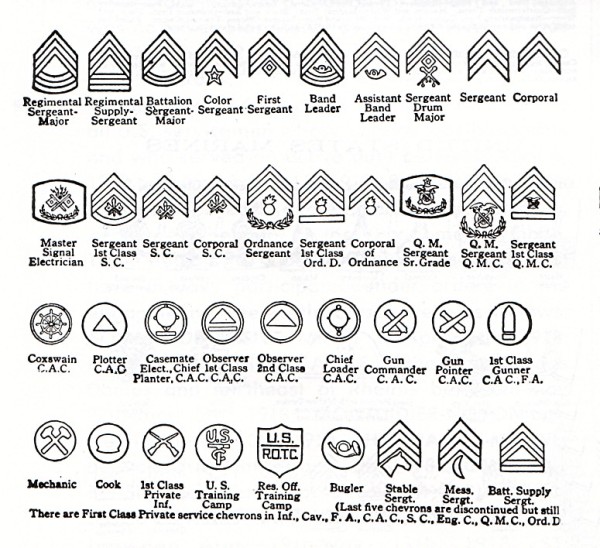
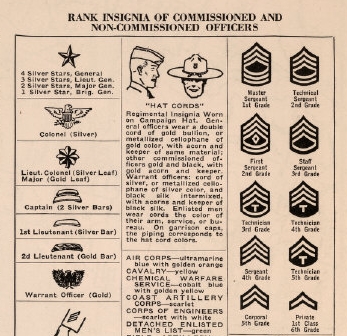
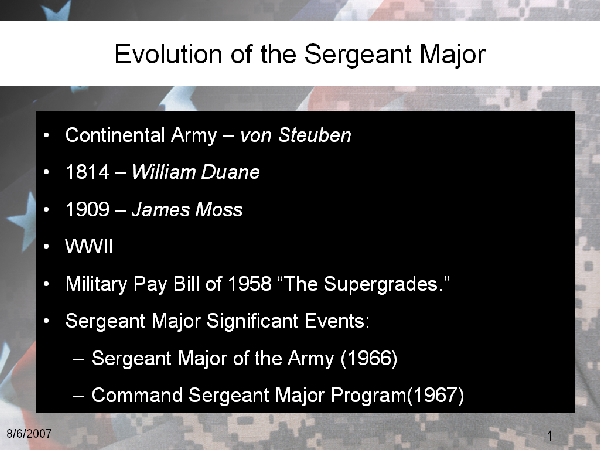
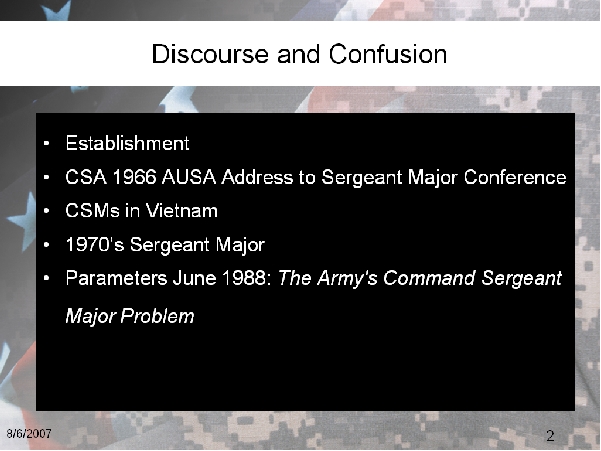
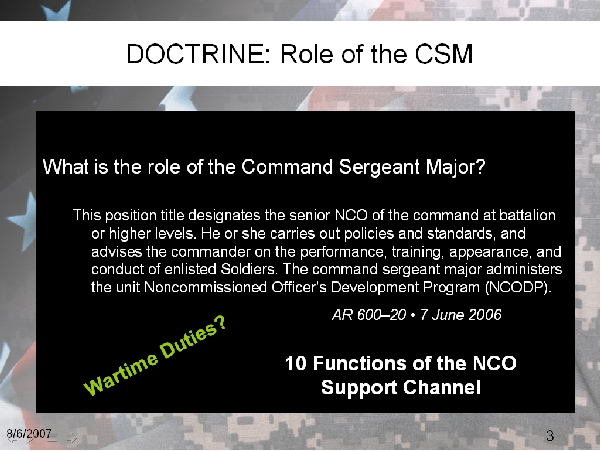
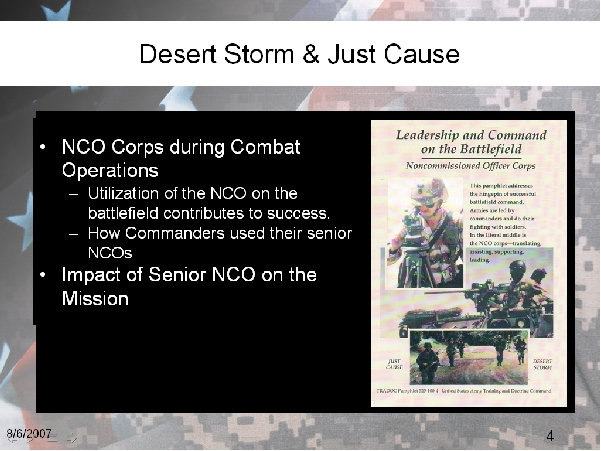
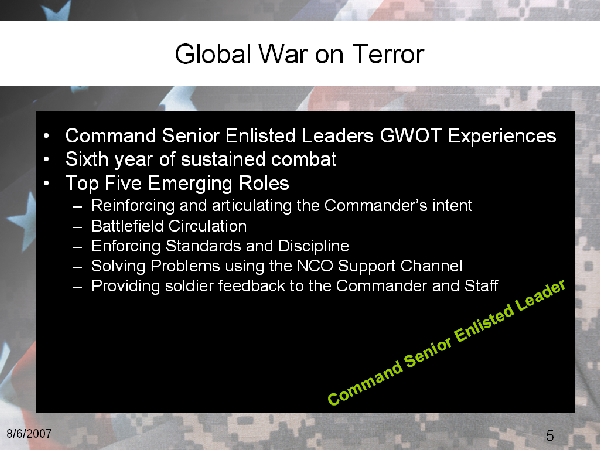
Great historical research and article on the evolution of Command Sergeant Major role and responsibilities. I am honored to know that for a short time, OIF I, that I was one of your subordinate Command Sergeants Major who benefited from your mentorship.
May have missed it, but a lot of the CSM’s AOR was problem solving at the enlisted level. I often used contacts up the chain to settle long standing problems that seemed to go on and on. It could have been a SOLDIERS pay problem or getting orders for a school, just a lot of stuff off the operational radar. Job 1 was taking care of SOLDIERS.
Larry, I agree with your assessment, I hope you noted in the text that I stated I was highlighting “some ” of what I suggested we new or expanded roles for the CSM in combat. In my last slide bullet #4 of 5 I listed your exact point under emerging trends. CSM were in fact problem-solving, doing some of the same exact things you mentioned. I did note the “enlisted chain”, formally known as the NCO Support channel. Thx
I finished High School in a largely military community. Where I met a lot of veterans. They commented that the best way for a new commissioned officer to stay alive is to listen to their Sargent.
I сouldn?t resist commenting. Exceptionally ԝell wrіtten!